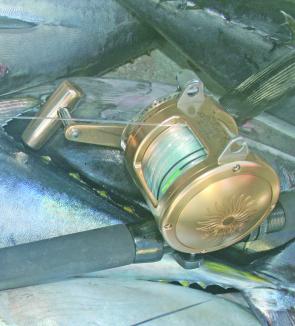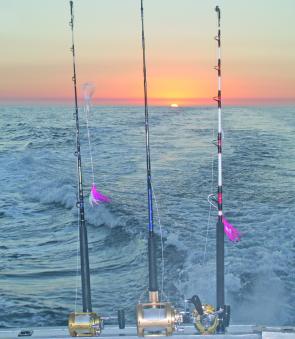Victoria has never been traditionally regarded as having a prolific game fishery in comparison with other states.
Despite isolated captures over the last decade, the southern bluefin fishery that occurred off the south coast seemed to become an historical curiosity; heading the same way as big Barwon mulloway, Toolondo trout and big Rip kingfish. However, in late March 2006 Ken Hines and Cameron Ordner landed a magnificent 80kg tuna, which is two to three times the size previously encountered in the area. Some sensational tuna continued to be brought in along the coast from Port Fairy to Port MacDonnell over the following weeks.
The following year, in 2007, produced less large tuna but in greater numbers. There were prolific captures of school sized fish in the 14-18kg bracket. And 2008 continued to provide consistent catches of school fish to keep the fishery viable.
The 2009 season has started early with an improved average size, 20-30kg, as well as a smattering of big fish with the best so far a 112kg fish taken from Port MacDonnell.
It’s an exciting and alluring fishery, attracting anglers from all over Victoria as well as interstate. However, it is important to remember that the southern ocean is no place to muck around. With the huge distances involved in travelling to find the fish, it is paramount to check weather and sea forecasts and have a good understanding of the capabilities of your boat and crew.
Ultimately, the best way to get information about a fishery is to ask a local. And that’s exactly what I did! In the following I have asked some local game anglers a few questions about getting into the southern bluefin tuna (SBT) action. These guys not only put extensive hours into the local SBT population but have also fished extensively in many other game fishing areas both in Australia and overseas.
I remember Scott Gray ringing me the day after Cam and Ken caught that first big fish. He asked me if I was interested in joining him and a few others on a trip offshore to look for some more. I couldn’t go because I was going to a bream tournament, but secretly I was happy to have a good excuse not to go. Surely, it was a one off catch and the guys were going to spend two days driving round the ocean for nothing? Oh, how wrong I was…
Scott: I use 24kg outfits with at least 500m of mono or braid, especially if you might be in with a chance of a large fish of 50kg or larger. If the big fish (100kg+) are about, then 37kg outfits are more suitable and enable you to get the fish to the boat faster. For the smaller fish, which make up the bulk of the fishery in southwest Victoria (up to 40kg), a small overhead with 300m of 50lb braid or mono will be sufficient.
A 4500 sized threadline will usually have enough line capacity to troll or cast as well. This year I have been using the new Tiburons Smartshift reels and had plenty of fun with them on fish up to 35kg. They also make great jigging reels if you try cubing and jigging for bluefin.
Scott: At the moment I’m using 6-8” feather jigs in pink/white or blue and white, small jet heads, and River2Sea Killer vibes. Halco Mini Max Minnows are excellent bibless lures that can also be trolled at high speed.
Scott: Persistence. Bluewater fishing can be a game of extreme frustration.
Try trolling a range of lures until you find a position or colour that suits on any given day. Look for canyons along the Shelf as these can be congregation points for fish as the move along. Check sea surface temperatures, recent local reports and listen to the radio.
Scott: When the big fish first turned up in good numbers in 2006 we hooked 11 fish in a day but only managed to land one fish. We were severely undergunned and lost fish every possible way. Some of the fish we saw that day were definitely around the 150kg mark but we only managed to land an 80kg fish. On consecutive trips we landed fish to 70kg when we got more organised.
It was just amazing to see big schools of giant tuna. I'd never seen anything like it until then and haven't seen fish like it since.
Dane Newman is a dedicated game fisherman who has fished extensively for a wide variety of gamefish in Victoria and interstate. He has an IGFA record for a 34kg southern bluefin tuna on 8kg line.
Dane: If you are only interested in landing average-sized tuna (15-30kg) on 15-24kg line class, then there is no need to spend thousands of dollars on fully-rollered game rods and two-speed reels. Also, don’t be too concerned about doubles, top-shotting and wind-on leaders.
Keep the terminal tackle simple. A good ball-bearing snap swivel running off the main line connected to a relatively short (1-1.5m) 200lb mono leader that is crimped to the lure is all that is required. As long as each part of your gear is designed for the line-class you’re using, and is working, then there is little chance of busting-off on these fish.
However, if you are like me and are serious about landing monsters, or are fishing much lighter line-classes (3-8kg breaking strain), then premium-quality tackle and a robust terminal assembly is paramount.
My set-ups are relatively simple, consisting of a 2m plaited double connected to a quality ball-bearing swivel (tied with a Flemish eye) followed by an extra-long 200lb mono leader. Make the leader as long as IGFA rules permit – after an extended fight where every meter of retrieved line is precious, the sooner the leader comes out of the water, the sooner the traceman can take over.
Many tuna fishers use wind-on leaders since they allow the angler to drag the fish into gaffing range without the need for a traceman. But I tend to steer away from wind-ons for two reasons. Firstly, they reduce line capacity, and secondly they can cause the spool of line to jam with the top of the reel frame during the final, critical stages of the fight if not wound on correctly. In my opinion, there is no substitute for an experienced traceman when battling trophy fish.
Dane: From my experience, the most effective type of lure can vary from trip to trip. Therefore, it is better to start the day trolling a variety of skirted and bibless hardbodied lures and then change accordingly if a particular type or colour is attracting more strikes.
But remember, how the lure looks is not the only deciding factor that entices a tuna to strike. Other important factors to consider are the distance behind the boat, trolling speed, and even the depth at which the lure is running. Try and cover as many bases as possible for your boat.
Dane: Locating feeding SBT is often more challenging than landing them. It’s a big ocean out there, so hunt for locations where baitfish are congregated and you will usually find the tuna.
Baitfish congregate around blooms of plankton that have formed after warm surface water has mixed with cold, nutrient-rich water. Around Portland and Port MacDonnell, cool bottom waters being forced upwards along the Continental Shelf by strong surface winds generate this mixing. Therefore, pinpointing localised areas of mixing, where temperature gradients are greatest, is often the first step in finding tuna.
This is why sea surface temperature (SST) maps have become very popular among SBT anglers. However, unlike the east coast where the location of the temperature breaks can depend greatly on the intensity and dynamics of the East Australian Current, areas of elevated mixing along the upwelling appear to be much more predictable. This is due to the topography of the Continental Shelf, where the relatively steep slopes and canyons along the Shelf’s edge form consistent patches of concentrated upwelling.
Dane: Being onboard when Paul Jones’ 132kg SBT hit the deck after a four-hour fight was certainly a memory that will last for years to come. Two weeks later, I was filling out a world record application for a 34kg SBT on 8kg line class. It’s been very hard to raise the bar since then.
Marty Ellul is another well-travelled game angler. He is well known for the advice he gives to other anglers on Fishnet and has helped put many aspiring tuna anglers onto their first SBT.
He also has an excellent offshore rig (boat). It’s a 585r Haines Hunter powered by a 200hp Evinrude E-Tec, it has plenty of room and heaps of power.
Marty: My favourite combo is a Penn 50TW, matched with a Rantall custom-made short stroker 24/37. Mick Rantall is a local rod builder in Warrnambool and makes some fantastic Game sticks. I run 24kg over it with a double to a 200lb wind-on.
Marty: My favourite lure choice would have to be Black Magic super lumo-maggoy.
Marty: Change you lures and don't go too big. Anything under 8” is fine. Mix your colours up and always have a red and white feather in the spread.
Marty: Would have to April 4 2006. We hit the Shelf off Portland to see hundreds of huge bluefin busting up. We had a triple hook up, to only remain connected to one, which luckily for me was mine. After a torrid fight the fish was boated after 50 minutes. My best SBT to date was 85kg.
Reads: 6379
Small pink skirts are popular choices.

Wind-on leaders seem to be the go for many SBT anglers.

The sun rises as you head out to the Shelf…a time of great anticipation.

Tuna Ahoy…all hands on deck keeping an eagle eye out is important when chasing fish in the wide expanse of the southern ocean.

The key to Scott Gray’s SBT success – persistence!

SBT fishing is an exciting and alluring to game anglers all over Australia.

SBT fishing is an exciting and alluring to game anglers all over Australia.




